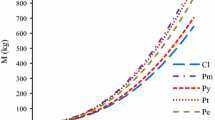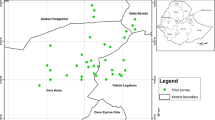Abstract
Small trees and saplings are important for forest management, carbon stock estimation, ecological modeling, and fire management planning. Turkish pine (Pinus brutia Ten.) is a common coniferous species and comprises 25.1% of total forest area of Turkey. Turkish pine is also important due to its flammable fuel characteristics. In this study, compatible above-ground biomass equations were developed to predict needle, branch, stem wood, and above-ground total biomass, and carbon stock assessment was also described for Turkish pine which is smaller than 8 cm diameter at breast height or shorter than breast height. Compatible biomass equations are useful for biomass prediction of small diameter individuals of Turkish pine. These equations will also be helpful in determining fire behavior characteristics and calculating their carbon stock. Overall, present study will be useful for developing ecological models, forest management plans, silvicultural plans, and fire management plans.





Similar content being viewed by others
References
Alemdag, I. S., & Horton, K. W. (1981). Single-tree equations for estimating biomass of trembling aspen, large tooth aspen and white birch in Ontario. The Forestry Chronicle, 57, 169–173.
Aydın, Ç. (2010). Construction of biomass tables of Pinus sylvestris in Artvin Forest Regional Headquarter (a case study of Borçka Planning Unit) (in Turkish). Dissertation: Karadeniz Technical University.
Bilgili, E., & Kucuk, O. (2009). Estimating above-ground fuel biomass in young Calabrian pine (Pinus brutia Ten.) in Turkey. Energy and Fuels, 23, 1797–1800.
Brandeis, T. J., Delaney, M., Parresol, B. R., & Royer, L. (2006). Development of equations for predicting Puerto Rican subtropical dry forest biomass and volume. Forest Ecology and Management, 233, 133–142.
Chaturvedi, R. K., & Raghubanshi, A. S. (2013). Aboveground biomass estimation of small diameter woody species of tropical dry forest. New Forests, 44, 509–519.
Claesson, S., Sahlen, K., & Lundmark, T. (2001). Functions for biomass estimation of young Pinus sylvestris, Picea abies and Betula spp. from stands in northern Sweden with high stand densities. Scandinavian Journal of Forest Research, 16, 138–146.
Dixon, R. K., Trexler, M. C., Wisniewski, J., Brown, S., Houghton, R. A., & Solomon, A. M. (1994). Carbon pools and flux of global forest ecosystems. Science, 263, 185–190.
Eker, M., & Ozcelik, R. (2017). Estimating recoverable fuel wood biomass from small diameter trees in Brutian pine (Pinus brutia Ten.) stands. Fresenius Environmental Bulletin, 26(12A), 8286–8297.
Eker, M., Poudel, K. P., & Ozcelik, R. (2017). Aboveground biomass equations for small trees of Brutian pine in Turkey to facilitate harvesting and management. Forests, 8, 477.
GDF. (2012). Genç meşcereler bakım seferberliği eylem planı 2012–2016 (in Turkish). Ankara: General Directorate of Forestry Publications.
GDF. (2013). Orman atlası (in Turkish). Ankara: General Directorate of Forestry Publications.
GDF. (2015). Türkiye orman varlığı 2015 (in Turkish). Ankara: General Directorate of Forestry Publications.
Goodale, C. L., Apps, M. J., Birdsey, R. A., Field, C. B., Heath, L. S., Houghton, R. A., Jenkins, J. C., Kohlmaier, G. H., Kurz, W., Liu, S., Nabuurs, G., Nilsson, S., & Shvidenko, A. Z. (2002). Forest carbon sinks in the Northern Hemisphere. Ecological Applications, 12, 891–899.
Guendehou, G. H. S., Lehtonen, A., Moudachirou, M., Mäkipää, R., & Sinsin, B. (2012). Stem biomass and volume models of selected tropical tree species in West Africa. Southern Forests, 74(2), 77–88.
Janzen, H. H. (2004). Carbon cycling in earth systems—a soil science perspective. Agriculture, Ecosystems & Environment, 104, 399–417.
Kahriman, A., Sönmez, T., & Şahin, A. (2017). Tree volume tables for Calabrian pine in Antalya and Mersin region. Kastamonu University Journal of Forestry Faculty, 17(1), 9–22.
Kurz, W. A., Beukema, S. J., & Apps, M. J. (1996). Estimation of root biomass and dynamics for the carbon budget model of the Canadian forest sector. Canadian Journal of Forest Research, 26, 1973–1979.
Kucuk, O., Bilgili, E., & Saglam, B. (2008). Estimating crown fuel loading for Calabrian pine and Anatolian black pine. International Journal of Wildland Fire, 17(1), 147–154.
IPCC (2003) Good practice guidance for land use, land-use change and forestry (Eds. Penman, J., Gytarsky, M., Hiraishi, T., Krug, T., Kruger, D., Pipatti, R., Buendia, L., Miwa, K., Ngara, T., Tanabe, K., & Wagner, T.). http://www.ipcc-nggip.iges.or.jp/public/gpglulucf/gpglulucf_contents.html
IPCC (2006) IPCC Guidelines for national greenhouse gas inventories (Eds. Eggleston, S., Buendia, L., Miwa, K., Ngara, T., & Tanabe, K.). http://www.ipcc-nggip.iges.or.jp/public/2006gl/index.html
Pajtík, J., Konôpka, B., & Lukac, M. (2008). Biomass functions and expansion factors in young Norway spruce (Picea abies [L.] Karst) trees. Forest Ecology and Management, 256, 1096–1103.
Papadopol, C.S. (2001) Climate change mitigation. Are there any forestry options? http://eco-web.com/edi/05934-03.html
Parresol, B. R. (1999). Assessing tree and stand biomass: a review with examples and critical comparisons. Forest Science, 45(4), 573–593.
Peichl, M., & Arain, M. A. (2007). Allometry and partitioning of above- and belowground tree biomass in an age-sequence of white pine forests. Forest Ecology and Management, 253, 68–80.
Rance, S. J., Mendham, D. S., Cameron, D. M., & Grove, T. S. (2012). An evaluation of the conical approximation as a generic model for estimating stem volume, biomass and nutrient content in young Eucalyptus plantations. New Forests, 43, 109–128.
Saeed, S., Ashraf, M. I., Ahmad, A., & Rahman, Z. (2016). The Bela forest ecosystem of district Jhelum, a potential carbon sink. Pakistan Journal of Botany, 48(1), 121–129.
Segura, M., & Kanninen, M. (2005). Allometric models for tree volume and total aboveground biomass in a tropical humid forest in Costa Rica. Biotropica, 37(1), 2–8.
Sönmez, T., Kahriman, A., Şahin, A., & Yavuz, M. (2016). Biomass equations for Calabrian pine in the Mediterranean region of Turkey. Šumarski List, 11-12, 567–576.
Tang, S., Li, Y., & Wang, Y. (2001). Simultaneous equations, error-in-variable models, and model integration in systems ecology. Ecological Modelling, 142(3), 285–294.
Tolunay, D. (2012). Biomass factors and equations for young Scots pine stands in Bolu-Aladağ (in Turkish). Journal of Faculty of Forestry Istanbul University, 62(2), 97–111.
Tolunay, D. (2013) Coefficients that can be used to calculate biomass and carbon amounts from increment and growing stock in Turkey (in Turkish). International Symposium for the 50th Anniversary of The Forestry Sector Planning in Turkey, 26–28 Nov. 2013, Antalya, Proceedings: 240–251.
UN (1992) Agenda 21. United Nations Conference on Environment and Development, 3–14 Jun. 1992, Rio de Jenario, Brazil.
UN (1998) Kyoto Protocol to the United Nations Framework Convention on Climate Change. United Nations.
UN (2015) Paris Agreement. United Nations.
Ünsal, A. (2007) Construction of biomass tables of Redpine in Karaisalı Forest Administration in Adana Forest Regional Headquarter (in Turkish). Dissertation, Zonguldak Karaelmas University.
Vogt, K. (1991). Carbon budgets of temperate forest ecosystems. Tree Physiology, 9, 69–86.
Wagner, R. G., & Ter-Mikaelian, M. T. (1999). Comparison of biomass component equations for four species of northern coniferous tree seedlings. Annals of Forest Science, 56, 193–199.
Xiao, C., & Ceulemans, R. (2004). Allometric relationships for below- and aboveground biomass of young Scots pine. Forest Ecology and Management, 203, 177–186.
Yılmaz, S. (2015) Determination of biomass of evenaged and pure stands of Pinus brutia in Antalya region (in Turkish). Dissertation, Artvin Çoruh University.
Zeng, W. S., & Tang, S. (2012). Modeling compatible single-tree aboveground biomass equations of Masson pine (Pinus massoniana) in South China. Journal of Forestry Research, 23(4), 593–598.
Zeng, W. S. (2015). Integrated individual tree biomass simultaneous equations for two larch species in northeastern and northern China. Scandinavian Journal of Forest Research, 30(7), 594–604.
Author information
Authors and Affiliations
Corresponding author
Rights and permissions
About this article
Cite this article
Sakici, O.E., Kucuk, O. & Ashraf, M.I. Compatible above-ground biomass equations and carbon stock estimation for small diameter Turkish pine (Pinus brutia Ten.). Environ Monit Assess 190, 285 (2018). https://doi.org/10.1007/s10661-018-6656-9
Received:
Accepted:
Published:
DOI: https://doi.org/10.1007/s10661-018-6656-9




